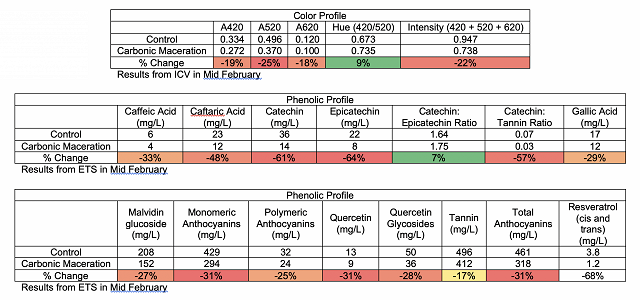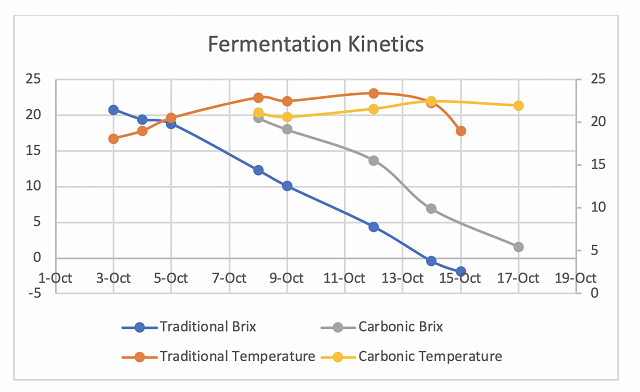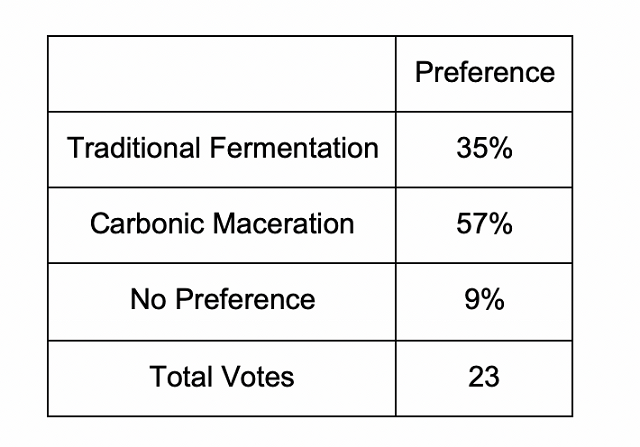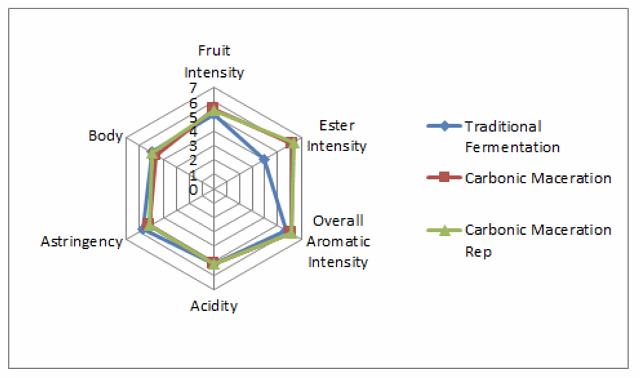Carbonic Maceration in Merlot (2017)
Kirsty Harmon
Blenheim Vineyards
Summary
This study examines the difference in aroma, flavor, and mouthfeel produced from fermenting Merlot traditionally versus through carbonic maceration. Merlot grapes were harvested on September 27, and some was split into a macrobin while the rest was added whole cluster to a carbon dioxide-flushed stainless steel tank. The carbonic maceration treatment tank was flushed with carbon dioxide twice per day, and the tank was not opened for 7 days. After 7 days, the carbonic maceration whole clusters were removed, and destemmed into a T bin, where it also received a more traditional fermentation. Musts in T Bins received 2 punchdowns per day. Both T Bins (the traditional and the carbonic maceration one) were pressed off on the same day (October 19). All other treatments between wines were equal. The carbonic maceration wine had lower ethanol, higher TA, and higher succinic acid. Most higher alcohols and esters were higher in the carbonic maceration wine. Color and phenolics were lower in the carbonic maceration wine. There was a significant sensory difference between the carbonic maceration and traditional fermentation wines (p<0.001), with a slight preference for the carbonic maceration wine. These results suggest that carbonic maceration reduces Astringency and increases Ester Intensity and Overall Aromatic Intensity.
Introduction
Carbonic maceration produces wines that are often characterized by their aromatic richness, softness, and balance. Generally these wines are characterized by intense estery and fruity notes at first, which quickly decline over time. Carbonic maceration occurs when unbroken berries (either destemmed or whole cluster) are held in a tank for an extended period of time under an inert gas atmosphere (often carbon dioxide). It has been recommended that this time be from 5-8 days at 30- 32°C, but this can vary widely depending on the style of wine desired. Glucose and malic acid is degraded inside the berry through anaerobic grape enzymatic reactions (intracellular fermentation). Malic acid can be degraded by up to half in this process, and about 1.5%-2% alcohol is formed. A concurrent yeast fermentation occurs in the free run juice, and often submerged grapes do not themselves undergo carbonic maceration (often because they are damaged from the weight of berries on top of them). Instead, the grapes which are only submerged in a carbon dioxide atmosphere themselves undergo maceration. Grapes are then pressed, and often the free run wine is kept separate from the press fraction juice in order to avoid lactic disease. This press fraction juice retains the carbonic maceration character, and must undergo a secondary yeast fermentation to complete alcoholic conversion of the sugars. Carbonic maceration wines generally have lower ethanol, titratable acidity, anthocyanins, and tannin, and have higher pH. They are also often characterized by higher succinic acid and succinic acid esters (Tesniere and Flanzy 2011). This study examined the impact of carbonic maceration on the chemical and sensory qualities of Merlot in comparison to traditional fermentation. The goal was to produce a carbonic maceration wine as a blending component to their red wine, in order to help fill out the middle of the wine.
Results and Discussion
The carbonic maceration wine had lower ethanol, higher TA, and higher succinic acid. Most higher alcohols and esters were higher in the carbonic maceration wine. However, the higher alcohols and fusel oil samples were stored in plastic bottles, which may have impacted results. Color and phenolics were lower in the carbonic maceration wine.



For the triangle test, of 30 people who answered, 24 people chose the correct wine (80%), showing a statistically significant difference between wines (p<0.001). These wines were voted to have an average degree difference of 5.5 (out of 10), suggesting that the wines were moderately different. In general, people who answered correctly had a slight preference for the carbonic maceration wine.

For the descriptive analysis, there was a strong trend for Ester Intensity to be higher in the carbonic maceration Wines (LSD=0.59), and for Astringency to be higher in the Traditional Fermentation wine (LSD=0.38). There was a slight tendency for Fruit Intensity and Overall Aromatic Intensity to be higher in the carbonic maceration wine as well.

These results suggest that carbonic maceration reduces Astringency and increases Ester Intensity and Overall Aromatic Intensity. Because the carbonic maceration wine in this study is intended to be used as a blending component in red winemaking at this winery, in the future blending trials should be performed. Additionally, different carbonic maceration techniques should continue to be investigated, such as altering the temperature and time of carbonic maceration.
Methods
Approximately 1.5 tons of Merlot was sourced and harvested on September 27, 2018 from the same vineyard and processed into two separate vessels.
Carbonic Maceration
This tank was first flushed and filled with carbon dioxide. Around 0.75 tons of whole cluster Merlot grapes were added to the tank and completely sealed. The tank had a pressure release valve that released excess carbon dioxide without allowing oxygen ingress.
Carbon dioxide was added to the tank twice daily for a period of 7 days (from loading to pressing). The pressure release valve released excess carbon dioxide once the headspace was filled with gas. The tank was not opened during this 7 day period. However, samples of free run juice were taken daily from the bottom valve of the tank to confirm the absence of objectionable amounts of ethyl acetate, acetaldehyde or acetic acid. The goal was to leave the tank closed for as long as possible until maceration was deemed complete or if objectionable levels VA were formed. The tank was transported into the sun each day for approximately 8 hours/day.
After 7 days, the tank was opened and grapes were transferred up a conveyor and into the destemmer. Destemmed fruit was loaded into a macrobin for “traditional” fermentation with two punchdowns per day. Inoculation of this macrobin was done by adding 5 liters of fermenting must from the “traditional” method fermentation. Brix and temperature were taken daily during fermentation.
Once fermentation progression slowed and Brix readings were negative, the grapes were pressed and wine/juice was put into tank to settle for 6 days before barreling down. Traditional method and carbonic bins were pressed the same day.
“Traditional” method fermentation.
0.75 tons of destemmed but not crushed grapes were loaded into the macrobin. 50 mg/L of sulfur dioxide was added at processing. EC1118 yeast was added at a rate of 10g/hL the day after processing. Two punchdowns were done daily until the carbonic fermentation had finished. Both bins were pressed on the same day (10/19). No acid or sugar adjustment were made. Wine was settled in tank for 6 days before being barreled (10/25).
Sensory Analysis
This project was tasted on February 28. For the triangle test, descriptive analysis, and preference analysis, anybody who did not answer the form were removed from consideration for both triangle, degree of difference, and preference. Additionally, anybody who answered the triangle test incorrectly were removed from consideration for degree of difference and preference. Additionally, any data points for preference which did not make sense (such as a person ranking a wine and its replicate at most and least preferred, when they correctly guessed the odd wine) were removed.
In order to balance the data set to perform statistical analysis for descriptive analysis on the February 28 tasting, any judge who had not fully completed the descriptive analysis ratings were removed. In order to then make the number of judges between groups equivalent, one judge from group 3 was transferred to group 1. This resulted in a final data set of 3 groups, each with 8 judges (considered as replications within groups, and groups were considered as assessors). Data was analyzed using Panel Check V1.4.2. Because this is not a truly statistical set-up, any results which are found to be statistically significant (p<0.05) will be denoted as a “strong trend” or a “strong tendency,” as opposed to general trends or tendencies. The statistical significance here will ignore any other significant effects or interactions which may confound the results (such as a statistically significant interaction of Judge x Wine confounding a significant result from Wine alone). The descriptors used in this study were Fruit Intensity, Ester Intensity (banana, bubblegum, etc), Overall Aromatic Intensity, Acidity, Astringency, and Body.
References
Tesniere, C. and Flanzy, C. 2011. Carbonic maceration wines: Characteristics and winemaking process. In: Advances in Food and Nutrition Research, Vol 63. Ed. Ronald S. Jackson. Burlington: Academic Press. pp. 1-15.
